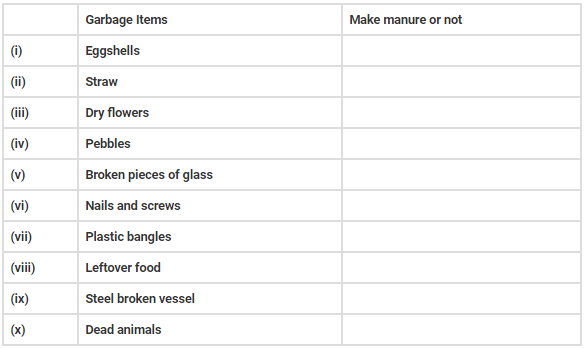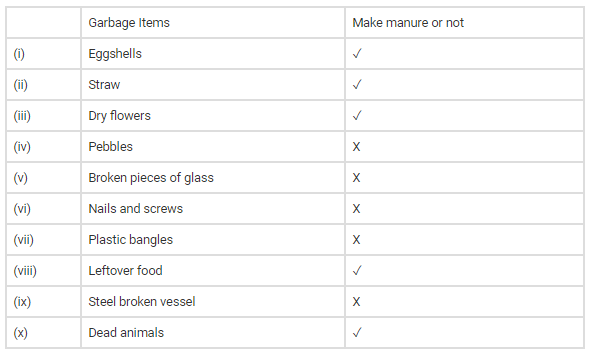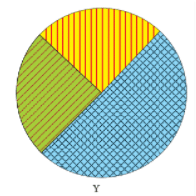NCERT Exemplar Solutions: Garbage In, Garbage Out | Preparation for NCEE - Primary 6 PDF Download
Multiple Choice Questions
Q.1. The method of preparing compost with the help of earthworms is called
(a) composting
(b) vermicomposting
(c) manuring
(d) decomposing
Ans: b
Solution: Earthworms help the quality of the soil. With the method of preparing compost with the help of earthworms is called as vermicomposting. This manure is rich in nutrients.
Q.2. If you dump kitchen waste in a pit, it may, after sometime
(a) convert into compost
(b) convert into vermicompost
(c) remain as such
(d) remain forever in its dried form.
Ans: a
Solution: Kitchen waste is biodegradable so it readily gets converted into compost. Vermicompost is formed when we introduce earthworms in the pit along with the waste.
Q.3. Which of the following activities does not reflect responsible behaviour with regard to waste disposal?
(a) Goods carried m paper bags or cloth bags.
(b) Waste collected in polythene bags for disposal.
(c) Waste separated into those that degrade and those that do not.
(d) Making handicrafts with used up notebooks.
Ans: b
Solution: Polythene bags are non-biodegradable. They remain as such in the environment and are very harmful for nature. Hence waste collected in polythene bags reflects irresponsible behaviour.
Q.4. Paheli gave the following ill effects of the practice of burning dried leaves and other plant parts.
(i) Burning degrades the soil.
(ii) Burning produces harmful gases/fumes.
(iii) Precious raw materials to obtain manure at a low cost is lost.
(iv) Lot of heat is generated unnecessarily.
The correct reasons of why we should not burn leaves are
(a) i, ii and iv only
(b) i, ii, iii and iv
(c) ii and iii only
(d) ii, iii and iv only.
Ans: b
Solution: Burning degrades the soil and also results in the loss of precious raw material that could be converted into useful compost. Burning of dried leaves and other plant parts produces smoke and harmful gases/fumes that generate a lot of heat and are harmful to our health.
Q.5. A garbage collector separate items mentioned below in the garbage into red, green and blue containers for their transfer to landfill, composting pit, and recycling unit respectively.
Items:
(i) Plastic bags
(ii) Newspaper and journals
(iii) Screw and nuts
(iv) Vegetable peels
(v) Metal chips
(vi) Eggshells
Which item was transferred to which bin?
Ans: c
Solution: Red bin containing, Plastic bags, screw and nuts, metal chips are non-degradable so they should be transferred to a landfill.
Green bin containing, Vegetable peels and eggshells are biodegradable so they should be transferred to a composting pit.
Blue bin containing, Newspapers and journals can be recycled, so they should be transferred to the recycling unit.
Q.6. The steps required for conversion of kitchen garbage into manure are given below in a jumbled form.
(i) Put garbage in a pit.
(ii) Cover the bottom of the pit with sand.
(iii) Cover the pit loosely with a gunny bag or grass.
(iv) Add worms.
Which of the following shows the correct sequence of the above steps?
(a) (ii); (i); (iv); (iii)
(b) (i); (ii); (iii); (iv)
(c) (ii); (iv); (i); (iii)
(d) (iv); (i); (ii); (iii)
Ans: a
Very Short Answer Questions
Q.7. Read the items mentioned in columns-l and II and fill in the related process in column III.
Ans: Here is the correct process:
Q.8. Correct the definitions of certain terms given below by changing only one word.
(i) Compost: Substances converted into manure for use in industries.
(ii) Landfill: Garbage buried underwater in an area.
(iii) Recycling: Reuse of unused material in the same or another form.
Ans: (i) Compost: It is a process in which substances converted into manure for use in agricultural fields.
(ii) Landfill: It is a process in which garbage buried under the soil in an area.
(iii) Recycling: It is a process in which reusing of used materials in the same or another form.
Q.9. Provide a suitable term that expresses the meaning of each of the following statements.
(a) Greeting cards made from newspaper.
(b) Contents of the waste bins.
(c) Worms converting certain kinds of waste into manure.
(d) An area where a lot of garbage is collected, spread out and covered with soil.
Ans: (a) Recycling
(b) Garbage
(c) Vermicomposting
(d) Landfill
Short Answer Questions
Q.10. To what use can you put the following kinds of garbage and how?
(i) Rotting smelly garbage
(ii) Dry leaves collected in garbage
(iii) Old newspapers
Ans: (i) Rotting smelly garbage is a biodegradable process. It can be converted into compost or vermicompost. Compost can be made by burying the organic waste such as fruit peels, vegetable peels, dry leaves etc. into a pit and covering it with soil. Vermicompost is made by using earthworms.
(ii) Dry leaves collected in a garbage can are converted into compost or vermicompost.
(iii) Old newspapers can be used for making the paper bags, paper pulp for use in handicrafts, covering books and also for making recycled paper.
Q.11. Paheli was writing a letter to her friend. She crumpled and threw the first draft of her letter on the floor as it had become untidy. Similarly, she crumpled and threw 6 more papers on the ground. In the end, she picked them up and put them in a polythene bag and threw it on the road outside her house. Do you think Paheli’s action were responsible? What would you have done if you were in her place?
Ans: No, Paheli’s action was that of an irresponsible citizen. By doing so, she is polluting the environment. Instead of wasting the used papers, she could use them in different ways. She is adding non-biodegradable waste to the environment by throwing a polythene bag on the road. If I were, at her place, then I would have either used the waste paper for doing rough work or converted the waste paper into paper pulp for decorating purpose or to make handicraft items.
Q.12. Read the poem written below and then answer the questions from the information gathered from the book or elsewhere.
(i) Name the two kinds of waste that need to be separated from each other in two different waste bins.
(ii) Name two items of waste each that need to be sent to a (a) landfill, (b) for composting
Ans: (i) The two kinds of waste that need to be separated from each other in two different waste bin are named as biodegradable waste and non-biodegradable waste.
The bin containing biodegradable waste can be converted into simpler forms with the help of microbes which can be used as manure.
The bin containing non-biodegradable waste cannot be converted nor recycled. Hence the waste can be used for landfill.
(ii) (a) The two items that can be sent to landfill are metal pieces, empty glass bottles, plastic plates etc.
(b) Wastes from the kitchen like vegetable peels, dry leaves, animal dung etc can be sent for composting.
Q.13. Beera, a farmer would clear his field every day, and burn dry leaves fallen on the ground. After some time he found that those living in huts near his field were suffering from cough and breathing problems.
(i) Can you explain why?
(ii) Also, suggest an environment-friendly way to dispose of the dry leaves.
Ans: (i) Burning of dry leaves releases harmful fumes and gases which causes cough, breathing problems etc. People living in huts near Beera’s field suffered from these problems as they inhaled the harmful fumes and gases released by the burning of dry leaves.
(ii) By the method of composting, dry leaves can be put in a pit and composed which is a method of preparing manure. It is an environmentally friendly way to dispose of the dry leaves. Farmers can use this manure produced from the dry leaves in the agriculture fields.
Long Answer Questions
Q.14. Put a tick (✓) against the garbage items given in Table 16.1 which could be converted into manure. Put a cross (X) against the others.
Ans:

Q.15. The pie charts A and B showed in Fig. 16.1 are based on waste segregation method adopted by two families X and Y respectively.

Which of the two families X or Y do you think is more environmentally conscious and why?
Ans: Family X is more environmentally conscious because they segregated biodegradable and non-biodegradable substances separately. They are aware of disposing of waste materials in the wrong manner. So, they disposed of kitchen waste (biodegradable) and polythene bags (non-biodegradable) separately unlike family Y who disposed of kitchen waste and polythene bags together as one waste.
Q.16. Given below are steps in vermicomposting and each step has been given an alphabet. Rearrange the steps in the correct sequence and write the alphabets on the chart provided. One step is done for you.
F Dig a pit in a suitable place, in your garden.
C Spread sand on the floor of the pit.
E Add vegetable peels and fruits waste in the pit.
A Sprinkle water to keep it moist
D Place red worms in the pit
B Cover with a gunny bag or grass
Step 1 – F
2 –
3 –
4 –
5 –
6 –
Ans: Step 1 – F
Step 2 – C
Step 3 – E
Step 4 – A
Step 5 – D
Step 6 – B
Q.17. Write 3 sentences on what comes to your mind when you chance to see the following.
(a) A rag picker.
(b) A cow eating a polythene bag.
(c) A foul odour emanating from garbage at the entrance of your house.
Ans: (a) A rag picker
(i) When we come across a rag picker, he represents poor people or under poverty people.
(ii) He sorts out the biodegradable waste from non- biodegradable waste.
(iii) He exposes himself to the harmful substances generated by the solid waste which causes various diseases.
(b) A cow eating a polythene bag
(i) A cow eating a polythene bag is unsafe, it shows the irresponsible behaviour of citizens by throwing garbage in the form of polythene bag.
(ii) A cow is exposed to hazardous material generating from the garbage.
(iii) A cow may choke itself from the polythene bag.
(c) A foul odour emanating from garbage at the entrance of your house
(i) It indicates the production of a large quantity of waste.
(ii) We expect others to clear the waste generated by us. This shows our irresponsibility towards garbage disposal.
(iii) The foul garbage shows unhealthy surrounding with an unpleasant sight which would lead to the spread of various diseases.
Q.18. Beautifully handcrafted articles like boxes and toys are made of paper pulp in our country. Can you explain how paper pulp which is made from paper can be used to make hard boxes and other articles?
Ans: Beautifully handcrafted articles like boxes and toys are made of paper pulp in our country. Here are a few steps on how it can be made:
The paper pulp obtained from the paper is mixed with glue and saw-dust. Using glue and saw-dust we can make the paper hard. So, for making hard boxes, toys, etc. few coats of this hard pulp are applied over the framework. It is then allowed to dry up. Once the pulp is dried up, hard boxes and toys can further be processed. Hence the box is ready.
Q.19. Recently, a ban on plastic bags has been imposed in many places? Is the ban justified? Give reasons in three sentences.
Ans: Yes, a ban on plastic bags is justified because:
(a) Plastic being non- biodegradable, it produces harmful gases on heating or burning. These gases may pollute the environment and cause many diseases for humans.
(b) Wastes are thrown using plastic bags onto roads or into rivers etc. when the animals eat the food along with the plastic bags it results in their death due to choking.
(c) Sewage system gets choked due to the blockage of waste in the drains. During heavy rains, it might even create a flood-like situation.
Q.20. Why should we not burn plastic items?
Ans: We should not burn plastic items because:
- On burning plastic, hazardous gases and fumes are emitted which are dangerous to human health and animals and also to the environment.
- Plastic is a non-biodegradable substance, so it cannot be easily burnt.
- Animals may consume the burnt pieces of plastic which may lead to their death by choking them.
- Burning plastic is not environment friendly it causes soil pollution and air pollution.
Q.21. What happens when?
(i) cooking medium is made to flow down a drain
(ii) insecticide, motor oil, paints are poured down the drain
(iii) Tea leaves, cotton swabs and old soft toys are thrown into the drain.
Ans: (i) When the cooking medium is made to flow down a drain, it may choke the pipes causing the drainage problem. And if the cooking medium reaches the soil, it will clog the pores of the soil which decrease soil fertility and pollute the soil.
(ii) When insecticides, motor oil and paints are poured down the drain, they may choke the pipes causing the drainage problem. And if the discharge reaches the water bodies, it pollutes the water and may cause various harmful diseases in aquatic animals.
(iii) Tea leaves, cotton swabs and old soft toys are thrown into drains it may choke the pipes causing the drainage problem. Hence the water does not flow down the drains and starts leaking in public places polluting the environment.
Q.22. Answer the following questions in one or two words or sentences.
(i) Why should we prefer to use paper bags rather than polythene bags?
(ii) Who, out of the following should properly dispose of the garbage – father, mother, elder brother, younger sister?
(iii) Which one out of beetles, roundworm and earthworm are used for vermicomposting and why?
Ans: (i) We should prefer to use paper bags rather than polythene bags because paper bags can be recycled and biodegraded but polythene bags being non-biodegradable they are harmful to humans, animals, plants and for the environment.
(ii) Every member of the family should dispose of the garbage properly. It should be a concern of every citizen, be it a mother, father, elder brother or younger sister.
(iii) Earthworms convert waste from plants and animals or their products into compost. Hence earthworms are used for vermicomposting.
|
254 videos|647 docs|140 tests
|
FAQs on NCERT Exemplar Solutions: Garbage In, Garbage Out - Preparation for NCEE - Primary 6
| 1. What is the meaning of the phrase "Garbage In, Garbage Out"? |  |
| 2. How does the concept of "Garbage In, Garbage Out" apply to waste management? |  |
| 3. What are the potential consequences of not following the principle of "Garbage In, Garbage Out" in data analysis? |  |
| 4. How can individuals contribute to the principle of "Garbage In, Garbage Out" in their daily lives? |  |
| 5. What are some measures that organizations can take to implement the principle of "Garbage In, Garbage Out" in data-driven decision-making? |  |
















